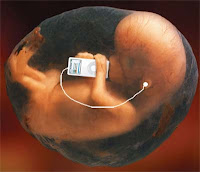 |
| A precocious case of auditory intentionality? |
The nihilation of the background: Heidegger vs. Sartre
Sloterdijk describes this primordial differentiation of figure (the mother's voice) and background (the uterine ambient noise) as the fetus’s first act of subjectivity, or at least as an act that underlies the subjectivity of the fetus:
“Turning a deaf ear and listening are original modes of pre-subjective ability… With this primordial choice between devotion and rejection, the first distinction in communicative behavior comes into force.” (Sphären I, p.512)
With this subjectivist description of the primordial differentiation of figure and background as the fetus’s first intentional act (“primordial choice”, “Urwahl”), however, Sloterdijk ignores an issue which should be familiar to him as a phenomenologist from the Heideggerian school, namely the dispute dispute between Sartre and Heidegger in their respective interpretations of the figure-background differentiation.
In Being and Nothingness Sartre offers – based more on Husserl and Hegel than on Heidegger – a strongly subjectivist interpretation of this differentiation as an active 'nihilation’ of the background by the human subject. Sartre's phenomenological basis for this position is set out in the famous and wonderfully Parisian example of ‘the café where Pierre is not’:
“When I enter this café to search for Pierre, there is formed a synthetic organization of all the objects in the café, on the ground of which Pierre is given as about to appear. This organization of the café as the ground is an original nihilitation.” (Being and Nothingness, Philosophical Library, New York 1956, p.9).
The café where Pierre is not
The intentional directedness of the human subject on an object (e.g. Pierre) always involves such a ‘nihilation’ of the environment (the café) in which the object must appear: the environment must recede into the background for the object to appear up front. According to Sartre, it is man wo accomplishes this nihilation. Thus “man is the being through whom nothingness comes to the world.” (Idem, p.24)
In the Letter on Humanism Heidegger discusses Sartre’s subjectivist interpretation of the background nihilation, criticizing it as a prime example of the modern humanistic overestimation of the subject. According to the ‘anti-humanist’ Heidegger, the ‘humanist’ Sartre (who did indeed say that “Existentialism is a humanism”) does not understand that the human subject only becomes a subject – i.e. an intentional being, focused on an object – through the nihiliation of the background against the backdrop of which the object can appear. One could say that this Heideggerian point is exactly what is shown by the example of the mother’s voice calling the fetal subject: the fetus only becomes an intentional subject through the nihilition of the uterine background noise thanks to which the mother’s voice can attract its attention. In general terms: a subject’s intentional directedness at an object becomes possible through this nihilation, which can therefore not be an act by the subject. Rather, as Heidegger argues, this nihilation is an ‘autonomous’ proces (or rather an heteronomous proces, since it subverts the subject’s autonomy): it is an anonymous ‘happening’ that constitutively precedes human subjectivity. Thus nothingness is not brought into the world by man, as Sartre says. According to Heidegger, it is exactly the reverse: nothingness brings man into the world.
For Heidegger, Being is the originally receding background that makes the world appear to man and which thus makes man himself appear as directedness at the world (Dasein as being-in-the-world). For Heidegger, then, Being is in a sense identical to Nothing, as it is the original nihilation that makes everything appear. Hence Heidegger’s notorious formula: “The Nothing nothings.” Heidegger’s ontological distinction, the difference between Being and beings, should therefore be understood in the context of Heidegger’s de-subjectivization of the figure-background differentiation, which becomes manifest in his critique of Sartre. This desubjectivization was precisely one of his innovations in relation to phenomenology and Gestalt psychology, where the notion of figure-background differentiation originated. Because of this desubjectivization, Heidegger could think the Being of beings in negative terms such as absence, disappearance and forgetting – as the original “hiddenness” that underlies the “un-hiddenness” of beings. Truth as the dis-closure of beings, what the Greeks called alethei, thus presupposes a primordial forgetting (lethe).
The café where Pierre is not
The intentional directedness of the human subject on an object (e.g. Pierre) always involves such a ‘nihilation’ of the environment (the café) in which the object must appear: the environment must recede into the background for the object to appear up front. According to Sartre, it is man wo accomplishes this nihilation. Thus “man is the being through whom nothingness comes to the world.” (Idem, p.24)
In the Letter on Humanism Heidegger discusses Sartre’s subjectivist interpretation of the background nihilation, criticizing it as a prime example of the modern humanistic overestimation of the subject. According to the ‘anti-humanist’ Heidegger, the ‘humanist’ Sartre (who did indeed say that “Existentialism is a humanism”) does not understand that the human subject only becomes a subject – i.e. an intentional being, focused on an object – through the nihiliation of the background against the backdrop of which the object can appear. One could say that this Heideggerian point is exactly what is shown by the example of the mother’s voice calling the fetal subject: the fetus only becomes an intentional subject through the nihilition of the uterine background noise thanks to which the mother’s voice can attract its attention. In general terms: a subject’s intentional directedness at an object becomes possible through this nihilation, which can therefore not be an act by the subject. Rather, as Heidegger argues, this nihilation is an ‘autonomous’ proces (or rather an heteronomous proces, since it subverts the subject’s autonomy): it is an anonymous ‘happening’ that constitutively precedes human subjectivity. Thus nothingness is not brought into the world by man, as Sartre says. According to Heidegger, it is exactly the reverse: nothingness brings man into the world.
 |
| Martin Heidegger |
 |
| Peter Sloterdijk |
Heidegger’s insight into the constitutive importance of negativity for the intentional relation between subject and object is surprisingly absent from Sloterdijk’s phenomenology of the sphere-forming relationship between the subject and his significant other. This becomes especially clear, as we have seen, in Sloterdijk’s subjectivist description of the appearance of the mother's voice to the fetus through the active ‘nihilation’ of the ambient noise in the uterus. According to Sloterdijk:
“the field of insignificance [i.e. the background of uterine ambient noise, PS] comes into existence first through the turning away of the ear from the annoying presences of noise; these are thereby “posited” [“gesetzt”] as non-informative or indifferent and are subsequently excluded from wakeful perception.” (Sphären I, 513)
But – to repeat the Heideggerian point – precisely because the fetus’s first hearing of the mother’s voice is the beginning of its intentional subjectivity, this nihilation of “the field of insignificance” cannot be an intentional act by the fetus. The receding into the background of the uterine noise first presents the mother’s voice to the fetus, who is thereby lured into subjectivity, that is, into intentional directedness at the voice. It can therefore not be the case that the “field of insignificance” arises only after the “turning away of the ear” which thereby “posits” the field as “non-informative or indifferent”, as if we were dealing here with a Fichtean “arch-positing” (“Ursetzung”) of Self and non-Self – a Fichtean connotation that is also evoked by Sloterdijk’s use in this context of the terms “primordial choice” (“Urwahl”, p.512) and “primal act of the self” (“Urhandlung des Selbst”, p.513). To be sure, there is no ‘Fichtean fetus’ – the fetus is not some ‘absolute I’ who conjures out of himself by means of negation the very (m)other in which it can come into existence…
Johann Gottlieb Fichte
Johann Gottlieb Fichte
Such a relapse into the subjectivism of German idealism can, of course, not be Sloterdijk’s intention. Hence the quotation marks around “posited” in Sloterdijk’s claim that the uterine ambient noise is “…“posited” as non-informative” (p.513). The quotation marks obviously indicate that the positing involved should not be understood in its traditional, philosophical, idealistic sense, as the self’s positing of the non-self through negation. But how then should we understand the nihilative ‘positing’ of the uterine ambient noise? If the nihilation of the uterine noise can not be an act by the fetus, who or what else brings about this nihilation? Should we here – following Heidegger's ontological critique of Sartre’s humanism – speak of Being hiding itself in order to make the mother’s voice present to the fetus?
But if so, doesn’t this then have the embarrassing – that is, embarrassing from a Heideggerian perspective – consequence that Being here ‘appears’ in the ontic guise of a specific being, namely in the guise of the ambient noise in the uterus? Doesn’t this violate the strictness of Heidegger’s ontological distinction between Being and beings? Is it possible for Being to ‘do its job’ in the form of a being, albeit a being that disappears as a vanishing mediator? Does Being need to be incarnated in vanishing mediators?
But if so, doesn’t this then have the embarrassing – that is, embarrassing from a Heideggerian perspective – consequence that Being here ‘appears’ in the ontic guise of a specific being, namely in the guise of the ambient noise in the uterus? Doesn’t this violate the strictness of Heidegger’s ontological distinction between Being and beings? Is it possible for Being to ‘do its job’ in the form of a being, albeit a being that disappears as a vanishing mediator? Does Being need to be incarnated in vanishing mediators?


No comments:
Post a Comment